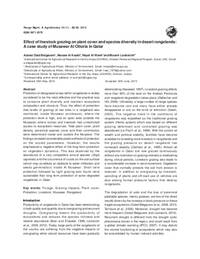Effect of livestock grazing on plant cover and species diversity in desert rangelands: A case study of Musawar Al Ottoria in Qatar

Authors:
Protection of designated areas within rangelands is widely
considered to be the most effective and the practical way
to conserve plant diversity and maintain ecosystem
composition and structure. Thus, the effect of protection
(two levels of grazing) at two sites in a rangeland was
monitored: inside Musawar (enclosure), where the
protection level is high, and an open area (outside the
Musawar) where human and livestock had unrestricted
access to ecosystem resources. Total plant cover, plant
density, perennial species cover and their contribution
were determined inside and outside the Musawar. The
findings revealed considerable positive effects of protection
on the scored parameters. However, the results
emphasized a negative effect of the long term protection
on vegetation dynamics. This was observed by the
abundance of a very competitive annual species (Stipa
capensis) and the occurrence of crusts on the soil surface
(which may constitute an obstacle to water infiltration and
seeds germination) inside Al Musawar. Short term
protection followed by light grazing was found more
sustainable than long term protection of some degraded
rangelands in Qatar.
